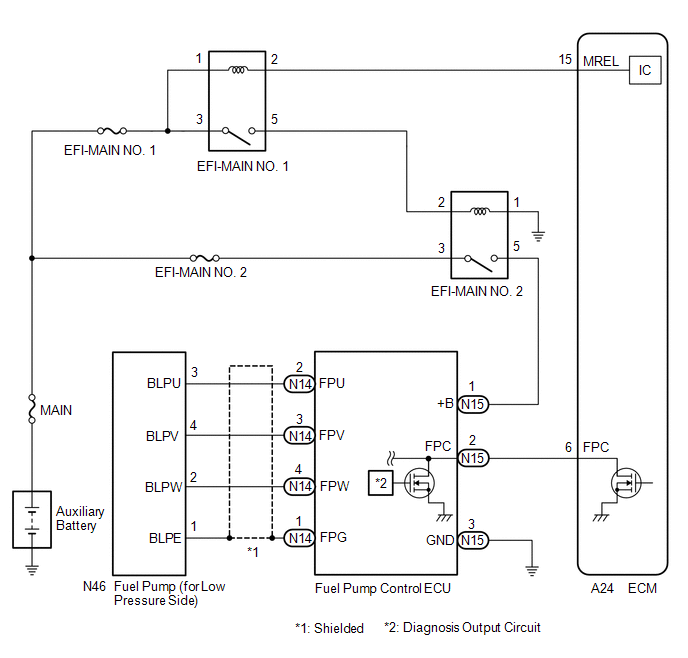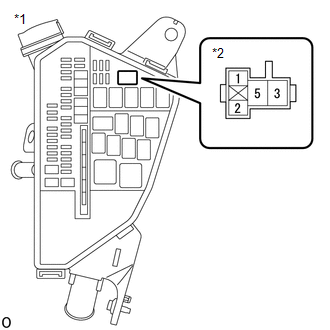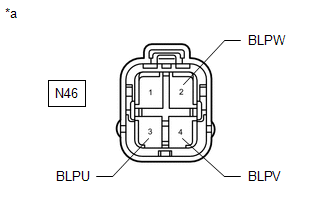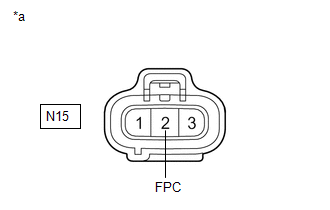| Last Modified: 01-30-2024 | 6.11:8.1.0 | Doc ID: RM100000001QF6D |
| Model Year Start: 2021 | Model: RAV4 | Prod Date Range: [08/2020 - ] |
| Title: A25A-FXS (ENGINE CONTROL): SFI SYSTEM: Fuel Pump Control Circuit; 2021 - 2024 MY RAV4 RAV4 HV [08/2020 - ] | ||
|
Fuel Pump Control Circuit |
DESCRIPTION
The fuel pump circuit consists of the ECM, fuel pump and fuel pump control ECU (which operates the fuel pump). Based on the engine output, the ECM determines the fuel pump speed. The speed is then converted to a duty signal and sent to the fuel pump control ECU. Based on the signal sent from the ECM, the fuel pump control ECU adjusts the fuel pump operation speed.
WIRING DIAGRAM

CAUTION / NOTICE / HINT
NOTICE:
Inspect the fuses for circuits related to this system before performing the following procedure.
PROCEDURE
|
1. |
CHECK FUEL LEAK |
(a) Check around and beneath the vehicle for fuel leaks, fumes, etc.
OK:
No fuel leaks present.
| NG |

|
REPAIR OR REPLACE FUEL LEAK POINT |
|
|
2. |
PERFORM ACTIVE TEST USING TECHSTREAM (ACTIVATE THE CIRCUIT RELAY) |
(a) Check whether the fuel pump operating sound occurs when performing the Active Test on the Techstream.
Powertrain > Engine > Active Test
|
Tester Display |
|---|
|
Activate the Circuit Relay |
Standard:
|
Techstream Operation |
Standard |
|---|---|
|
ON |
Operating sounds can be heard from fuel pump (for low pressure side) |
| NG |

|
|
|
3. |
PERFORM ACTIVE TEST USING TECHSTREAM (CONTROL THE FUEL PUMP DUTY RATIO) |
(a) Install the fuel pressure gauge (for low pressure line of low pressure side).
(b) Compare the values in the Data List using the Techstream and the fuel pressure gauge when the Active Test was performed.
Powertrain > Engine > Active Test
|
Active Test Display |
|---|
|
Control the Fuel Pump Duty Ratio |
|
Data List Display |
|---|
|
Fuel Pressure (Low) / Fuel Pressure 2 |
|
Fuel Pump Control Duty Ratio |
Standard:
|
Techstream Operation |
Standard |
|---|---|
|
Low |
Data List value and fuel pressure gauge are within +/-50 kPa of each other |
|
High |
HINT:
Perform "Inspection After Repair" after replacing the fuel pressure sensor (for low pressure side).
| NG |

|
REPLACE FUEL PRESSURE SENSOR (FOR LOW PRESSURE SIDE) HINT: Perform "Inspection After Repair" after replacing the fuel pressure sensor (for low pressure side). |
|
|
4. |
READ VALUE USING TECHSTREAM (FUEL PRESSURE) |
(a) Read the values displayed on the Techstream while the engine is cranking.
Powertrain > Engine > Data List
|
Tester Display |
|---|
|
Target Fuel Pressure (Low) / Target Fuel Pressure 2 |
|
Fuel Pressure (Low) / Fuel Pressure 2 |
|
Low Fuel Pressure Sensor |
|
Result |
Proceed to |
|---|---|
|
Low Fuel Pressure Sensor value is within +/- 65 kPa of the Target Fuel Pressure (Low) / Target Fuel Pressure 2 |
A |
|
Low Fuel Pressure Sensor value is higher than 65 kPa higher than the target fuel pressure (low) |
B |
|
Low Fuel Pressure Sensor value is higher than 65 kPa lower than the target fuel pressure (low) |
C |
HINT:
Perform "Inspection After Repair" after replacing the fuel pump (for low pressure side).
| B |

|
REPLACE FUEL PUMP (FOR LOW PRESSURE SIDE) |
| C |

|
|
|
5. |
CHECK FUEL PRESSURE |
(a) Install the fuel pressure gauge (for low pressure line of low pressure side).
(b) Start the engine.
(c) Measure the fuel pressure at idle.
Standard Fuel Pressure:
196 to 833 kPa (2.0 to 8.5 kgf/cm2, 28 to 121 psi)
HINT:
Refer to Standard Idle Speed.
(d) Stop the engine.
(e) Check that the fuel pressure remains as specified for 5 minutes.
Standard Fuel Pressure:
98 kPa (1.0 kgf/cm2, 14.2 psi) or higher
HINT:
Perform "Inspection After Repair" after replacing the fuel pump (for low pressure side).
| OK |

|
PROCEED TO NEXT SUSPECTED AREA SHOWN IN PROBLEM SYMPTOMS TABLE |
| NG |

|
REPLACE FUEL PUMP (FOR LOW PRESSURE SIDE) HINT: Perform "Inspection After Repair" after replacing the fuel pump (for low pressure side). |
|
6. |
CHECK SHORTAGE OF FUEL |
(a) Check the amount of fuel remaining.
HINT:
- No fuel remains in the fuel tank: Malfunction of the fuel sender gauge assembly is suspected.
- Only the fuel pump side fuel chamber has no fuel remaining: Malfunction of the jet pump is suspected.
- Fuel remains in the fuel tank: Malfunction of the fuel pump (for low pressure side) is suspected.
- Perform "Inspection After Repair" after replacing the fuel pump (for low pressure side).
| NEXT |

|
REPLACE FUEL PUMP (FOR LOW PRESSURE SIDE) HINT: Perform "Inspection After Repair" after replacing the fuel pump (for low pressure side). |
|
7. |
PERFORM ACTIVE TEST USING TECHSTREAM (FUEL PUMP SINGLE PHASE ENERGIZATION) |
|
(a) Disconnect the fuel pump (for low pressure side) connector. |
|
(b) Operate the fuel pump control ECU using the Active Test function and measure the voltage according to the value(s) in the table below.
Powertrain > Engine > Active Test
|
Tester Display |
|---|
|
Fuel Pump Single Phase Energization |
Standard Voltage:
|
Tester Connection |
Techstream Operation |
Specified Condition |
|---|---|---|
|
N46-3 (BLPU) - Body ground |
U Phase |
4.4 to 8.4 V* |
|
N46-4 (BLPV) - Body ground |
V Phase |
4.4 to 8.4 V* |
|
N46-2 (BLPW) - Body ground |
W Phase |
4.4 to 8.4 V* |
HINT:
- *: This Active Test restricts the fuel pump control ECU output duty cycle to 50%. Therefore, the output voltage of the fuel pump control ECU will be approximately 50% of the power source voltage.
- Before performing this inspection, check that the auxiliary battery voltage is between 11 and 14 V (not depleted).
| OK |

|
REPLACE FUEL PUMP (FOR LOW PRESSURE SIDE) HINT: Perform "Inspection After Repair" after replacing the fuel pump (for low pressure side). |
|
|
8. |
CHECK HARNESS AND CONNECTOR (FUEL PUMP CONTROL ECU - FUEL PUMP) |
(a) Disconnect the fuel pump control ECU connector.
(b) Disconnect the fuel pump connector.
(c) Measure the resistance according to the value(s) in the table below.
Standard Resistance:
|
Tester Connection |
Condition |
Specified Condition |
|---|---|---|
|
N14-2 (FPU) - N46-3 (BLPU) |
Always |
Below 1 Ω |
|
N14-3 (FPV) - N46-4 (BLPV) |
Always |
Below 1 Ω |
|
N14-4 (FPW) - N46-2 (BLPW) |
Always |
Below 1 Ω |
|
N14-2 (FPU) or N46-3 (BLPU) - Body ground and other terminals |
Always |
10 kΩ or higher |
|
N14-3 (FPV) or N46-4 (BLPV) - Body ground and other terminals |
Always |
10 kΩ or higher |
|
N14-4 (FPW) or N46-2 (BLPW) - Body ground and other terminals |
Always |
10 kΩ or higher |
| NG |

|
REPAIR OR REPLACE HARNESS OR CONNECTOR |
|
|
9. |
CHECK HARNESS AND CONNECTOR (POWER SOURCE OF FUEL PUMP CONTROL ECU) |
|
(a) Disconnect the fuel pump control ECU connector. |
|
(b) Turn the ignition switch to ON.
(c) Measure the voltage according to the value(s) in the table below.
Standard Voltage:
|
Tester Connection |
Switch Condition |
Specified Condition |
|---|---|---|
|
N15-1 (+B) - N15-3 (GND) |
Ignition switch ON |
11 to 14 V |
HINT:
Make a note of the measured voltage as it may be used in a following Active Test.
| NG |

|
|
|
10. |
INSPECT ECM (FPC TERMINAL) |
|
(a) Disconnect the fuel pump control ECU connector. |
|
Powertrain > Engine > Active Test
|
Tester Display |
|---|
|
Fuel Pump Single Phase Energization |
(b) Operate the fuel pump control ECU using the Active Test function and measure the resistance according to the value(s) in the table below.
Standard Resistance:
|
Tester Connection |
Techstream Operation |
Specified Condition |
|---|---|---|
|
N15-2 (FPC) - Body ground |
Before Active Test → During Active Test |
Before Active Test: Resistance is stable → During Active Test: Resistance fluctuates* |
HINT:
*: Using the Active Test, duty control of the transistors in the ECM will be performed. Due to the duty control, resistance of the FPC terminal will be unstable during the Active Test. If the resistance is stable before the Active Test and fluctuates while performing the Active Test, it can be determined that the transistor is operating. If the transistor does not operate during the Active Test, the ECM may be malfunctioning.
| OK |

|
|
|
11. |
CHECK HARNESS AND CONNECTOR (FUEL PUMP CONTROL ECU - ECM) |
(a) Disconnect the fuel pump control ECU connector.
(b) Disconnect the ECM connector.
(c) Measure the resistance according to the value(s) in the table below.
Standard Resistance:
|
Tester Connection |
Condition |
Specified Condition |
|---|---|---|
|
N15-2 (FPC) - A24-6 (FPC) |
Always |
Below 1 Ω |
|
N15-2 (FPC) or A24-6 (FPC) - Body ground and other terminals |
Always |
10 kΩ or higher |
| OK |

|
| NG |

|
REPAIR OR REPLACE HARNESS OR CONNECTOR |
|
12. |
CHECK HARNESS AND CONNECTOR (FUEL PUMP CONTROL ECU - BODY GROUND) |
(a) Disconnect the fuel pump control ECU connector.
(b) Measure the resistance according to the value(s) in the table below.
Standard Resistance:
|
Tester Connection |
Condition |
Specified Condition |
|---|---|---|
|
N15-3 (GND) - Body ground |
Always |
Below 1 Ω |
| NG |

|
REPAIR OR REPLACE HARNESS OR CONNECTOR |
|
|
13. |
CHECK HARNESS AND CONNECTOR (POWER SOURCE VOLTAGE OF EFI-MAIN NO. 2 RELAY) |

|
*1 |
No. 1 Engine Room Relay Block and Junction Block Assembly. |
|
*2 |
EFI-MAIN NO. 2 Relay |
(a) Remove the EFI-MAIN NO. 2 relay from the No. 1 engine room relay block and junction block assembly.
(b) Measure the voltage according to the value(s) in the table below.
Standard Voltage:
|
Tester Connection |
Condition |
Specified Condition |
|---|---|---|
|
3 (EFI-MAIN NO. 2 relay) - Body ground |
Always |
11 to 14 V |
| NG |

|
REPAIR OR REPLACE HARNESS OR CONNECTOR (AUXILIARY BATTERY - EFI-MAIN NO. 2 RELAY) |
|
|
14. |
INSPECT EFI-MAIN NO. 2 RELAY |
| NG |

|
REPLACE EFI-MAIN NO. 2 RELAY |
|
|
15. |
CHECK HARNESS AND CONNECTOR (EFI-MAIN NO. 1 RELAY - EFI-MAIN NO. 2 RELAY) |
(a) Remove the EFI-MAIN NO. 1 relay and EFI-MAIN NO. 2 relay from the No. 1 engine room relay block and junction block assembly.
(b) Remove the EFI NO.1 fuse and D INJ relay, EFI-MAIN NO. 3 relay from the No. 1 engine room relay block and junction block assembly.
HINT:
Remove the EFI NO.1 fuse and D INJ relay and EFI-MAIN NO. 3 relay connected between the checked terminals as the coil inside the relay influences the measurement value.
(c) Measure the resistance according to the value(s) in the table below.
Standard Resistance:
|
Tester Connection |
Condition |
Specified Condition |
|---|---|---|
|
5 (EFI-MAIN NO. 1 relay) - 2 (EFI-MAIN NO. 2 relay) |
Always |
Below 1 Ω |
|
5 (EFI-MAIN NO. 1 relay) or 2 (EFI-MAIN NO. 2 relay) - Body ground and other terminals |
Always |
10 kΩ or higher |
| NG |

|
REPAIR OR REPLACE HARNESS OR CONNECTOR |
|
|
16. |
CHECK HARNESS AND CONNECTOR (EFI-MAIN NO. 2 RELAY - BODY GROUND) |
(a) Remove the EFI-MAIN NO. 2 relay from the No. 1 engine room relay block and Junction block assembly.
(b) Measure the resistance according to the value(s) in the table below.
Standard Resistance:
|
Tester Connection |
Condition |
Specified Condition |
|---|---|---|
|
1 (EFI-MAIN NO. 2 relay) - Body ground |
Always |
Below 1 Ω |
| NG |

|
REPAIR OR REPLACE HARNESS OR CONNECTOR |
|
|
17. |
CHECK HARNESS AND CONNECTOR (EFI-MAIN NO. 2 RELAY - FUEL PUMP CONTROL ECU) |
(a) Remove the EFI-MAIN NO. 2 relay from the No. 1 engine room relay block and junction block assembly.
(b) Disconnect the N15 fuel pump control ECU connector.
(c) Measure the resistance according to the value(s) in the table below.
Standard Resistance:
|
Tester Connection |
Condition |
Specified Condition |
|---|---|---|
|
5 (EFI-MAIN NO. 2 relay) - N15-1 (+B) |
Always |
Below 1 Ω |
|
5 (EFI-MAIN NO. 2 relay) or N15-1 (+B) - Body ground and other terminals |
Always |
10 kΩ or higher |
| OK |

|
| NG |

|
REPAIR OR REPLACE HARNESS OR CONNECTOR |
|
|
|

![2019 - 2024 MY RAV4 HV [02/2019 - ]; A25A-FXS (FUEL): FUEL SYSTEM: ON-VEHICLE INSPECTION+](/t3Portal/stylegraphics/info.gif)


